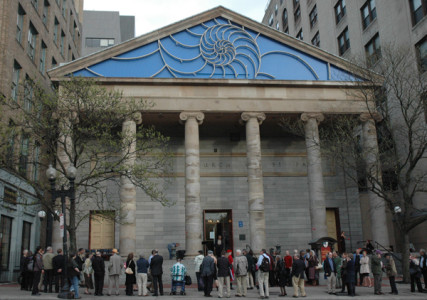
The Episcopal Cathedral Church of St. Paul, which overlooks Boston Common, updated its facade with an aluminum sculpture depicting a cross-sectioned chambered nautilus. Photo courtesy of The Cathedral Church of St. Paul.
What is the Episcopal Church?
A decade ago, the Episcopal Church was front page news in national media when New Hampshire faithful elected a gay bishop. Editors assumed readers would see this as a significant moment in U.S. religion. One scholar in 2003 likened the Episcopal Church to California. “Things happen there that they know will happen in the rest of the churches,” said anthropologist of religion Susan Harding.
On gay religious and political rights and opportunities that has proven true — for California. For the Episcopal Church, not so much.
Wednesday’s Washington Post, in a sad news story about another bishop, felt it necessary to add a description of the Episcopal Church as “a small but historically prominent American Protestant denomination.”
Has this church has gone from influential to afterthought, from elite to obscure, in record time? Yes and no.
It was always a small church but at least people knew it was an American Protestant denomination without being told. And they knew many of the Founding Fathers and 11 U.S. presidents prayed in Episcopal pews.
Now, when even the U.S. Supreme Court has no Protestant justices, that’s no longer common knowledge. Hence, the Post’s rare-bird-sighting treatment complete with taxonomy.
We have seen whole American religious landscape shift, denominational lines blur and points of religious distinction — theological and cultural — flatten out.
Or it may be that in nearly a quarter century since the first American Religious Identification Survey asked “What is your religious identity?” we have seen more documentation, more research, more reporting and classifying who is spiritually who.
Waves of surveys by ARIS, Pew Research Center and the Public Religion Research Institute — adding to data from the General Social Survey and the Gallup Poll — delineate our beliefs and behavior to a degree unknown before the ’90s. These reveal how American religion is not what we think it is today — or thought it was in yesteryear.
Consider the “Nones,” people who claim no faith brand label. This is a rough category, stewing together everyone from atheists to spiritual seekers to folks who don’t spend a minute searching for the inner meaning of life. Surveys show the nones numbers have soared from 8 percent of U.S. adults to nearly 20 percent. Or did they?
Maybe it has simply become culturally acceptable for people to come out of the church/synagogue closet and admit that they let go of defined systems and institutional religion. Maybe they were hidden nones all along.
The Episcopal Church still stands, still has a voice in the culture, as membership has steadily dwindled from 2.3 million a decade ago to 1.86 million in 2013.
So, keep your eyes peeled. You might spot one of those rare Episcopal Church folks out there. Now you know who they are.




